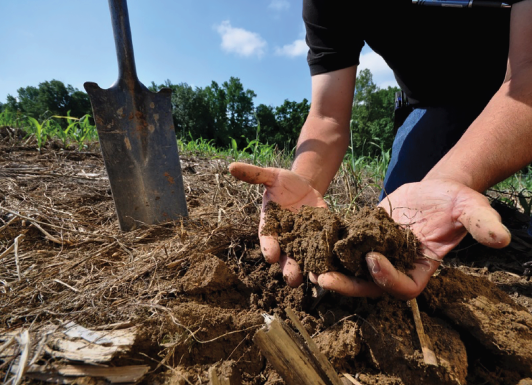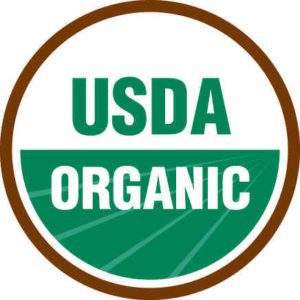

Oct 25, 2018Moving toward organic production, certification
The growth in the organic sector has caught the interest of many people. Growing vegetables is already a challenge and growing in accordance with the USDA National Organic Program (NOP) standards brings a different set of challenges. To get the green USDA Organic badge involves many considerations and lots of commitment, but can pay off with the right markets, those seeking organic produce and that will pay a premium price.
Here are some approaches and organizations to help you get started farming organically when seeking USDA NOP organic certification. Each step that you complete can lead you closer to a more environmentally sound and successful farm, as well as NOP organic certification.
Step 1: Get started on the paperwork


For many farmers, the paperwork is the greatest challenge, but if you plan at the onset you can reduce this burden. One option is to use labeled filing folders compiled by year. Another option is any one of a number of software programs that can be used for those who rely on a computer for their business record keeping. There are software applications that can help you with record keeping specifically for organic certification such as Cog-Pro and Ag- Squared. A paper filing system can be used as well. Either way, a bit of organization up front can go a long way. Detailed recordkeeping and organized management of documents are the foundation of your application for organic certifications, as well as evaluations of profitability.
Step 2: Take advantage of resources, programs
During your planning stage, you may have realized where your knowledge gaps are. Luckily, there are many programs and resources that can prevent you from re-inventing the wheel. As you consider how to transition to organic and get certified, check if your state has a program operated by the Department of Agriculture or a local non-profit organization that guides farmers to improve their farming practices. Seek their input and guidance, as they often have a program in place to address gaps in farm practices that impact sustainability and economics. Also, visit with your local Soil Conservation District Office to see what is available for new organic and sustainable farmers.
In the state of Michigan, we have an excellent program, MAEAP Michigan Agriculture Environmental Assurance Program (www.maeap.org) which is free and is offered to farmers with farms of all sizes. MAEAP is a way to assess how practices impact the environment and ultimately the farm’s bottom line. A key point is that MAEAP provides guidance to improve the farm’s sustainability and does not impose regulatory actions. Finally, with each iteration of the farm bill comes a set of cost-share programs that can help you reach your sustainability goals such as cost-share of organic certification fees.
Step 3: Observe your fields
One analysis that does not cost anything is observation. Visiting your fields after a weather event such as a heavy rain, snowmelt or during a windstorm can help you identify how well the soil is protected from the elements. For example, notice where water does and does not drain well within the fields. Consider what types of cover crops would be most beneficial at different locations or if you implement a different tillage system. Notice the direction of the wind. Consider a windbreak if the soil is blowing. Notice weed populations across the field. Are there perennial weeds that may need to be rogued until control is achieved? This approach can help you to get to know how your soil responds to different actions and what steps you need to take to improve it.
Step 4: Taking soil samples
After identifying what was done on that piece of land over the past three years it is important to develop a plan for the next three years that will allow you to apply for organic certification.
The basis for this plan will be soil testing for nutrients, texture, pH and soil organic matter, as these are critical components of soil health and will be your starting point. If an older home was located on the land then you may want to have the soil checked for lead (Pb) as well, a contaminant found in pre-1972 house paint. Be sure to indicate to the laboratory that you are using organic practices so they can respond with recommendations appropriate for organic farming.
Putting in place a consistent soil sampling plan is important. Although it may not be necessary to sample every year, make a plan to document trends in soil organic matter and soil fertility over time. Organic matter takes several years to build up before you start to see differences, requiring annual soil testing for nutrients while organic matter only every three to five years. A sample can be worthwhile or worthless depending on how it is taken. Try to take soil samples around the same of year, after harvest in the fall is a common time. Consider how many soil samples you need to collect from your fields. If there are contrasting soil types in a field or noticeable differences in soil texture, you may want to take a soil sample from each area of the field. Collect between 15-20 sub-samples from across the field for each sample. Mix each sample and remove debris. You can have your sample processed at any land-grant university or at a private soil analysis laboratory. Results from the labs will be emailed or mailed to you. If you question the results or need help with interpretation contact the lab that conducted the assessments.
Step 5: Find the right organic certifier
After three years of following organic practices and keeping records, you are ready to identify an organic certifier to inspect and certify your farm. You may want to choose an agency earlier in order to start a correspondence and consider advice. You are not committed to that agency until you pay the membership fees.
Carefully select an organic certification agent based on your farming type and their responses to your questions. It is your dollar, so interview them like anyone else you hire to do work. If you like their style of management and see they have experiences related to your farming type then consider applying to them for organic certification. It is important to note, they can help you to understand what is requested in the application and the process to become certified, but they cannot offer you advice about your farming. Seek production advice from agriculture specialists such as your local extension educator, private agriculture consultants and other organic farmers. When interviewing potential agencies, be sure to ask what fees they charge for certification for your type of farming operation. Once you choose the agency, request a membership packet and then begin filling out the forms. The packet should provide a timeline to follow and explain the costs of certification for your farm. It will, of course, include the forms that you need to complete to apply for organic certification. If you prefer to do the forms on the computer, ask the agency to send them electronically. As you need help to complete the forms you should contact your certifying agency.
Starting a new farm or switching farming practices is not easy, but with determination and smart use of resources, it can be done. The NOP Organic program has been in place since 2002. Farmers from all states obtained organic certification for their farming system over these past sixteen years, and many are willing to share their experiences and resources. The land-grant universities can assist you in understanding your soil tests, using cover crops, seeking the best variety for growing in your area, growing high quality and safe food as well as identifying new markets. Resources are abundant. It’s up to you to put them to use.
– Vicki Morrone, Michigan State University
Top photo: Consistent soil sampling plays an important role in creating a plan to obtain organic certification.














